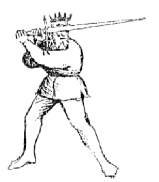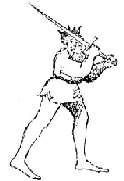Flos DuelletorumFlower of Battle | |
 
| |
| Very little is known of the master swordsman "Fiore dei Liberi da
Premmariacco" except what he describes of himself in his prologue. Fiore
(pronounced "Fee-or-ray"), was born in Cividale del Friuli sometime in the
mid 1300's. In the late 1300's he trained in Germany under "Master Johannes,
the Swabian", who was himself a pupil of "Niklaus of Toblem" from the
diocese of Metz. Dei Liberi later adapted his teachings to his own methods.
He describes that he had been practicing the art of swordsmanship for "fifty
years" when he began writing his text. In the text he states he took part in
numerous battles in and around Italy for the last 20 years of the 14th
century, including, in 1383 he fought in Udine, fighting on the side of the
town during the civil war. In 1395 he was in Padua for a duel and four years
later in 1399 he was in Pavia. Then in 1400 he was appointed master
swordsman to the court of Niccolo III d'Este, Marquise of Ferrara and later
acquired a commission as a master swordsman on behalf of Signore di Ferrara.
He then began to write the manuscript for the knightly nobility and
dedicated his treatise to the marquise. Dei Liberi appears to have died
before 1450. The historical influence of Die Liberi's teachings is still
being determined, but for modern students of the sword it is priceless.
In his text he cautions against teaching his art to the masses, who won't understand it and won't use it to noble ends. He implores the practitioner to use great care in practicing, less they maim or kill their friends, but in warfare, riot or duel to use it with full power and speed, for no man at arms can show kindness to his enemy. In his segno are the eight cuts, the various posta, and four animals. The wolf symbolizes prudence, or the use of timing and measure. The tiger speed, and the lion bravery. He says that in order to use the animals properly they must be contrasted, meaning that prudence, speed and bravery must be perfectly balanced and one must not be overabundant or it will compromise the other two. The elephant with the tower on its back indicates a solid, erect stance. You will find the illustrations indicate just such a stance. Flos Duellatorum, or Flower of Battle exists today in three versions: the Getty, the Morgan and the Novati manuscripts. The Morgan and Getty versions of the work seem to be fairly similar, possessing a great deal of text; while the Novati is a departure from the other two, it's text primarily written in short rhyming couplets and its illustrations not as well rendered. The Novati version of Flos Duelletorum is the most widely recognized and may be found elsewhere on the World Wide Web. Members of St. Martin's Academy are currently assisting in the translation of the Getty and Morgan copies of the manuscript. Each version of the Flos Duelletorum is divided into sections comprehensively dealing with wrestling, dagger, sword, spear, pollaxe and finally, mounted combat with lance and sword. |
|
| To learn more about how you can participate with the St. Martin's Academy of Medieval Arms e-mail us! | |
|
More About St. Martin's | Class Schedule | Links to Related Sites | Home | |